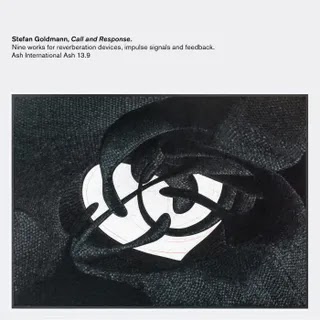Reverb is the sole ingredient on the German-Bulgarian artist’s latest conceptual record, in which vintage pedals and digital processors are used to mimic the properties of sound in impossible spaces.
In 1947, Bill Putnam discovered the future of music in the men’s room of Chicago’s Civic Opera Building. Putnam, a World War II veteran, was an electrical engineer and a born tinkerer, and he had recently set up a cutting-edge recording studio on the top floor of the Art Deco office tower. Searching for a way to add lifelike echo to a harmonica quartet’s rendition of the 1912 standard “Peg o’ My Heart,” he set up a loudspeaker in one of the building’s marble-walled bathrooms. Piped in from down the hall, and subsequently picked up by an auxiliary microphone, the band’s instruments were bathed in an eerie shimmer, like wraiths in an enchanted cave. Artificial reverb was born, and popular music has never been the same since.
Reverb’s psychoacoustic properties are as old as humans’ connection with the supernatural itself; they are engineered into Byzantine churches, Mayan pyramids, and Neolithic burial chambers. But Putnam’s gambit was a development befitting the coming Space Age. To add artificial reverb to a recording is to bend the rules of spacetime—to abduct the listener from the room they inhabit and deposit them in a cathedral or a canyon or a catacombs, while slowing or even freezing the ticking of the clock, smearing milliseconds into the illusion of infinity.
Echo chambers such as Putnam’s soon gave way to plate and spring units capable of sculpting even more dynamic effects. By 1976, $20,000 could buy you a digital gizmo armed with real-time controls; two decades later, Sony made it possible to “sample” real-world spaces, applying mathematical models of the way that sound travels through a bounded set of dimensions. Today, wildly inventive plugins for DAWs such as Logic and Ableton do everything from mimicking Motown’s legendary echo chambers to allowing producers to invent perpetually shifting spaces, turning caverns into tin cans and back again.
Stefan Goldmann’s Call and Response is a tribute to this evolution of space as an instrument in its own right. Plenty of contemporary electronic music uses reverb as seasoning, but Goldmann’s album might be the only record in which reverb is the sole ingredient. Across nine tracks bearing titles like “Brick and Mortar” and “Glowing Walls,” Goldmann deploys a range of techniques on vintage and contemporary devices, “playing” the reverb as he adjusts parameters like density, damping, diffusion, and decay. There are no conventionally musical tones; the only inputs are short, neutral clicks deployed to trigger the resulting reverb, and even these are often rendered inaudible, smothered by the charcoal puffs of dust kicked up around them.
The record’s subtitle—Nine works for reverberation devices, impulse signals and feedback—carries the faint whiff of a laboratory experiment, and the music is correspondingly ascetic. The German-Bulgarian artist frequently works along similarly conceptual lines: On one album, he cut up dozens of canonical recordings of Stravinsky’s Le Sacre du Printemps; for another, he utilized only factory presets from obsolete Japanese workstation synthesizers from the 1990s. But Call and Response is by far his most austere undertaking. Philosophically, the idea is similar to no-input music, a Japanese noise subgenre in which performers route a mixing desk’s output back into its input, sculpting the resulting feedback into stark filaments. If no-input music attempts to capture the sound of nothingness, Call and Response might be an answer to the question, “What is the sound of nothing turning itself inside out?”
Still, this is not a clinical study but a fantastical journey; its purpose is not didactic but psychedelic. The opening “Quarry” lays out the palette utilized across the entire album: one thousand shades of gray. Short clacks are stretched into the caws of robotic crows. The crunch of metal turns into a gunshot booming across a valley. For all its yawning sense of absence, Call and Response is often vividly imagistic; in the absence of musical cues, your brain struggles to fill in the blanks. You imagine thunderclaps, artillery shells whizzing overhead, slow-motion avalanches dissolving into wispy plumes. Extended passages of white noise are stretched into long, thin wires; deep inside the asphalt-colored churn, train whistles sing.
The preponderance of gray sometimes makes Call and Response feel aggressively drab; it’s not a very fun exercise, despite artificial reverb’s potential to evoke purely imaginary spaces. The music is at its most engrossing when feedback chains create steady rhythms. In “Traction,” what sounds like the dull throb of a boat engine is followed by what might be a foghorn tapping out Morse code, while “Two Shelves” begins with elastic undulations that sound like kneading metal. And in a few places, bizarre acousmatic effects may make you doubt your own perception: There’s a quick flicker of buzz in “Quarry” that briefly sounds like it’s emanating from inside your own skull, and in “Relic,” I could have sworn that the music was vibrating the pull tab on the Coke can sitting on my desk. (It wasn’t.) But by and large, there’s little opportunity to get comfortable in these renderings of what Goldmann calls “impossible architecture”: The halls may be enormous, but the abiding sensation is overwhelmingly claustrophobic.



0 comments:
Post a Comment